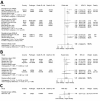Systematic Review and Meta-analysis of Deaths Attributable to Antimicrobial Resistance, Latin America
- PMID: 37877573
- PMCID: PMC10617342
- DOI: 10.3201/eid2911.230753
Systematic Review and Meta-analysis of Deaths Attributable to Antimicrobial Resistance, Latin America
Abstract
Antimicrobial resistance is a pressing global health concern, leading to 4.95 million deaths in 2019. We conducted a systematic review and meta-analysis to assess the lethality attributed to infections caused by multidrug-resistant organisms (MDROs) in Latin America and the Caribbean. A comprehensive search of major databases retrieved relevant studies from 2000-2022. We included 54 observational studies, primarily from Brazil, Argentina, and Colombia. The most commonly studied organism was methicillin-resistant Staphylococcus aureus. The overall unadjusted case fatality rate related to MDROs was 45.0%; higher adjusted lethality was observed in persons infected with MDROs than in those infected with other pathogens (adjusted odds ratio 1.93, 95% CI 1.58-2.37). A higher lethality rate was seen in patients who did not receive appropriate empirical treatment (odds ratio 2.27, 95% CI 1.44-3.56). These findings underscore the increased lethality associated with antimicrobial resistance in Latin America and the Caribbean.
Keywords: Argentina; Brazil; Caribbean region; Colombia; Latin America; antimicrobial resistance; bacteria; lethality; methicillin-resistant Staphylococcus aureus; mortality.
Figures




References
-
- World Health Organization. GLASS method for estimating attributable mortality of antimicrobial resistant bloodstream infections [cited 2023 Oct 12]. https://www.who.int/publications/i/item/9789240000650
-
- O’Neill J. Tackling drug-resistant infections globally: final report and recommendations. 2016. [cited 2023 Oct 12]. https://apo.org.au/node/63983
-
- National Office of Animal Health. NOAH response to final O Neill AMR review report July 2016. [cited 2022 Nov 21]. https://www.noah.co.uk/wp-content/uploads/2016/07/FINAL-NOAH-response-to...
Publication types
MeSH terms
Substances
LinkOut - more resources
Full Text Sources
Medical

